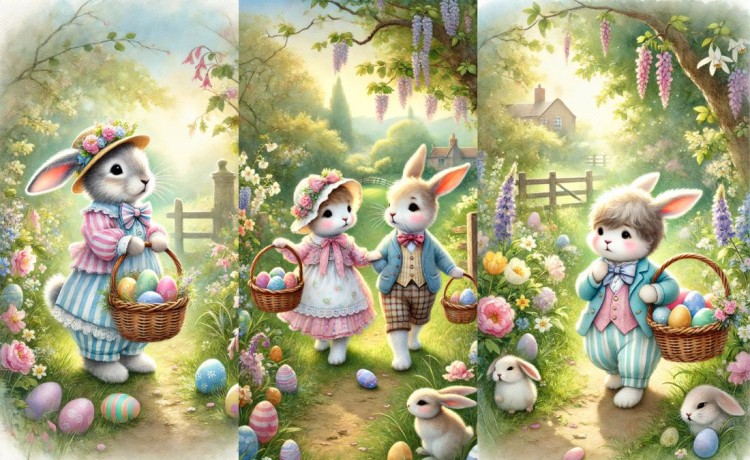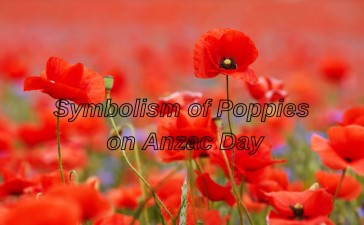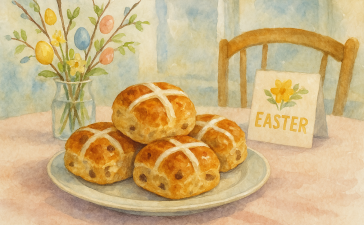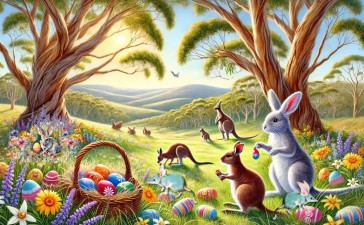Easter Bunnies Series by Harrison Lamoureux
Easter is one of the most significant celebrations in the Christian calendar, marking the resurrection of Jesus Christ. While religious traditions focus on themes of renewal, redemption, and faith, Easter has also developed a rich cultural side, filled with egg hunts, chocolate treats, and, of course, the beloved Easter Bunny. But where did the idea of a rabbit delivering eggs come from, and what is its connection to Easter?
The Origins of the Easter Bunny
The Easter Bunny as we know it today is believed to have originated from pre-Christian and pagan traditions that celebrated spring and fertility. In many ancient cultures, rabbits were seen as symbols of fertility and new life due to their prolific reproduction rates.
One of the most well-known origins links the Easter Bunny to Eostre, the Anglo-Saxon goddess of spring and fertility. According to folklore, Eostre had a sacred animal companion—a hare. The hare was associated with fertility, renewal, and the changing of the seasons. Some versions of the legend even suggest that Eostre transformed a bird into a hare, which then laid coloured eggs as a gift. This myth may have been an early inspiration for the concept of an egg-laying rabbit.
Eostre, the Anglo-Saxon goddess of spring and fertility
How the Easter Bunny Became Part of Christian Easter Traditions
As Christianity spread across Europe, many pagan customs were absorbed into Christian celebrations to ease the transition for converts. Easter, which already aligned with springtime festivals, naturally adopted some fertility symbols, including eggs and rabbits.
The first recorded mention of the Easter Bunny in a more modern sense comes from 17th-century Germany, where a folkloric figure known as “Osterhase” (Easter Hare) was said to lay colourful eggs for well-behaved children to find. German immigrants later brought this tradition to America in the 18th century, where it gradually evolved into the chocolate-giving, egg-hiding bunny we recognise today.
Why Rabbits and Not Another Animal?
The choice of a rabbit, rather than another animal, is significant for several reasons:
- Fertility and New Life – Rabbits reproduce quickly, symbolizing abundance and new beginnings, which align with both springtime themes and the resurrection of Christ as a renewal of life.
- Lunar Connection – Some historians believe that rabbits, associated with the moon in various ancient cultures, played a role in Easter, as the holiday is based on the lunar calendar (celebrated on the first Sunday after the first full moon following the spring equinox).
- German Folklore Influence – In many European traditions, hares (a relative of rabbits) were seen as mystical creatures with divine connections, reinforcing their place in religious customs.
The Symbolism of Easter Eggs
Rabbits are not the only prominent symbol of Easter—eggs also play a crucial role. While eggs were originally a symbol of fertility in pagan traditions, Christians later adopted them to represent the tomb of Jesus and the promise of new life through resurrection.
The tradition of decorating eggs dates back centuries, with early Christians in Mesopotamia coloring eggs red to symbolize the blood of Christ. Over time, this practice evolved into the modern Easter egg hunts and the chocolate eggs we enjoy today.
Modern-Day Easter Bunny Traditions
Today, the Easter Bunny is a fun and festive figure that delivers treats to children, much like Santa Claus at Christmas. Some of the most popular customs include:
- Easter Egg Hunts – Children search for hidden eggs, sometimes filled with candy or small prizes.
- Chocolate Easter Bunnies – The tradition of making chocolate bunnies became popular in the 19th century.
- Easter Baskets – Many children receive baskets filled with chocolates, sweets, and toys.
Despite its non-religious origins, the Easter Bunny has become a universal symbol of joy and renewal, blending ancient traditions with modern celebrations.
Egg Hunting by Harrison Lamoureux
Final Thoughts
While the Easter Bunny may not have direct biblical roots, its association with fertility, renewal, and the arrival of spring makes it a fitting symbol for Easter. The combination of pagan traditions, Christian symbolism, and folklore from Germany has shaped this beloved character into a central figure of modern Easter celebrations.
Whether you see it as a whimsical holiday mascot or a representation of deeper seasonal themes, the Easter Bunny continues to bring joy to families worldwide, reminding us of the renewal, hope, and happiness that Easter represents.
- Find out more
- Launch Pad + Accelerator Expressions of Interest
- Selling and Licensing Your Art & Designs Around the World with ArtSHINE.
We’re here to help you to take action, just like we’ve helped thousands of other entrepreneurs, business owners, and creative professionals all around the globe.
Now is the time to let your passion SHINE.
Now is the time to Make Tomorrow Today!
To your success, Vinh Van Lam and Stuart Horrex Cofounders ArtSHINE.com







